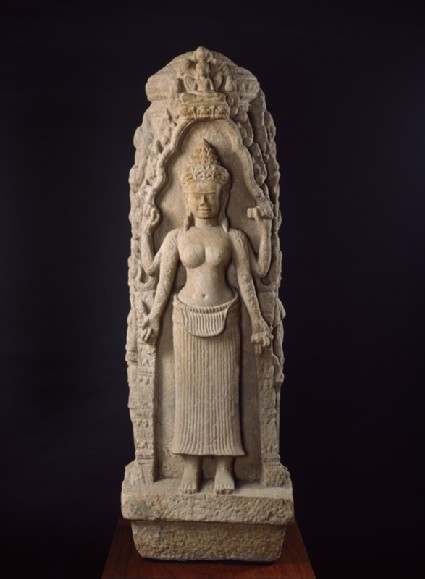Browse: 13 objects
- Reference URL
Actions
Buddhist chaitya
-
Description
This monolithic Khmer chaitya, in the form of a miniature tower-shrine, once stood within a temple complex to mark the limits of the sacred precinct. Its principal deity is the goddess Prajnaparamita (‘The Perfection of Wisdom’), who personifies the transcendental knowledge embodied in the great Mahayana Buddhist Sutra (wisdom text) of that name. She holds a rosary and a sacred text in her upper hands. Also depicted on the chaitya are Avalokiteshvara and two indistinct female deities.
-
Details
- Associated place
-
Asia › South-east Asia › Cambodia › Prasat Ta Mean (place of creation)
- Date
- mid-10th century AD
- Material and technique
- sandstone
- Dimensions
- 110 x 33 x 36 cm approx., max. (height x width x depth)
- Material index
- Technique index
- Object type index
- No. of items
- 1
- Credit line
- Purchased with the assistance of funds provided by the Art Fund, the MCG/ V&A Purchase Grant Fund, and the Friends of the Ashmolean Museum, 1999.
- Accession no.
- EA1999.102
-
Further reading
Bunker, Emma C., and Douglas Latchford, Adoration and Glory: The Golden Age of Khmer Art, ed. John Stevenson (Chicago: Art Media Resources, 2004), no. 58 a & b on pp. 184-185
Glossary
chaitya
-
chaitya
An early Buddhist or Jain shrine or assembly hall; or, a small Buddhist votive shrine representing a tower or miniature temple, placed within a temple complex.
Location
Objects are sometimes moved to a different location. Our object location data is usually updated on a monthly basis. Contact the Jameel Study Centre if you are planning to visit the museum to see a particular object on display, or would like to arrange an appointment to see an object in our reserve collections.
Galleries
© 2013 University of Oxford - Ashmolean Museum






